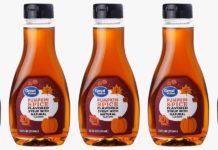Never ask a Scotsman, “Scotch vs. whiskey, aren’t they the same?” because they’ll do a spit-take at the question. Luckily, we put together this guide to help you understand the difference between Scotch and whiskey so you’re prepared next time the subject comes up. Here’s the simplest answer: Scotch is a type of whisky made in Scotland. If you just clocked the change in spelling for “whiskey” (no E), good eye! Scotland as well as Canada and Japan spell it “whisky” whereas the United States and Ireland spell it “whiskey.” This article will use the spelling that corresponds to the spirit’s country of origin. (A handy way to remember is that the countries with E in the name spell “whiskey” with the E.) So to circle back, all Scotch is whiskey but not all whiskey (or whisky) is Scotch. Curious where Bourbon falls in the mix? Check out our Bourbon vs. Whiskey guide for more information.
What is whiskey?
Whiskey is a spirit distilled from a fermented mash of grains, then often aged in barrels. There are many kinds of whiskey, including bourbon, rye, Scotch, Irish whiskey and Japanese whisky. What distinguishes each is the grain used in the mash. For Scotch, it’s predominantly malted barley. Bourbon, on the other hand, must be distilled mostly with corn, while rye whiskey must have a majority of — you guessed it — rye in the mash. No matter your preference, we’ve got you covered with the top affordable bottles in each category in our roundup of Best Whiskey Brands.
What is Scotch?
Scotch is a spirit usually distilled from malted barley then aged in oak barrels or oak casks. As with most spirits, there are a whole host of rules dictating how Scotch must be produced. According to the Scotch Whisky Association, “All Scotch whisky must legally be at least three years old,” and “by law the minimum bottling strength is 40% alcohol by volume.”
Three years, however, is often just the minimum age for Scotch. You’ll find drams aged for much longer — think 10, 15 or 18 years. For super premium (and super pricey) bottles, you’ll see them aged over 20 years.
Another rule: Scotch must be made entirely in Scotland. If during production, a barrel even meanders over the border to England, it’s no longer considered a true Scotch whisky.
The above guidelines are just a rough sketch of what defines Scotch. There are different types of this whisky and, in the final rendering, one can taste completely different from the next.
What are the types of Scotch?
Single malt: The malt here refers to the malted barley, the only grain allowed for single malts. Contrary to popular belief, a single malt isn’t from a single batch or barrel. The term means that the Scotch is from a single distillery. So a single malt Scotch, such as GlenDronach, can be a blend of whiskies from different years and casks — but they must all originate from that one distillery; in this case, GlenDronach.
And what is malted barley exactly? It’s barley that’s been soaked and allowed to sprout. This step makes it easier for the grain to ferment into alcohol.
Blended malt: Not to be confused with blended grain Scotch or blended Scotch, this type is a mix of different single malts from multiple distilleries. Unlike the other blended types, blended malt Scotch does not include any grain whisky.
Single grain: Like single malts, single grain Scotches must be made at a single distillery. The biggest difference is that a single grain does not have to be made exclusively with malted barley and — this is where the name might be confusing — it can be made with one or more cereals (malted or not), such as wheat, corn or rye. So instead of being smoky, a single grain Scotch is likely to be lighter-bodied and mellow with a sweeter profile.
Another difference between a single malt and single grain is that the latter is less expensive and easier to make in large quantities. Therefore, it’s mainly been used to make blended Scotch (scroll down for more on this type).
Blended grain: This milder, lighter type is a marriage of single grain Scotches from multiple distilleries. Although it’s uncommon, there are blended grain Scotches that the truly whisky curious will seek out and enjoy.
Blended: The most encompassing type, a blended Scotch is a mix of one or more single malts with one or more single grain Scotches from different distilleries. It’s by far, the most prevalent among the five types of Scotch and some of the most easy-drinking. Many recognizable brands are blended Scotch: Dewar’s, Johnnie Walker and The Famous Grouse, to name a few.
Are single malts better than blended Scotches?
No, they’re just a different style. Jon Favreau’s character in the movie Swingers did the blended category dirty when he ordered a Scotch on the rocks. “Any Scotch will do, as long as it’s not a blend, of course,” he says to the bemused bartender. “Single malt, Glenlivet, Glenfiddich perhaps, maybe a Glen Ga—any Glen.”
Single malts are prized among many whisky enthusiasts: The idea of a whisky from one place that retains the character of the distillery is compelling, for sure. But the truth is, there are great blends out there (some might even say they’re richer and more complex than single malts). Also true: There are not-so-great ones out there. Since it’s easier to make blended Scotches, they outnumber single malts so increase the probability of encountering inferior examples.
What does Scotch taste like?
Many people think of Scotch as a smoky whisky. And, yes, it can be. Some distilleries dry the barley over a peat fire, which lends the final product its signature smolder. But a lot of the flavor depends on the type of Scotch and the region where it’s made (more on that later). In general, though, you can expect hints of caramel, vanilla, oak and spice.
What are the Scotch regions?
There are five Scotch regions, each with its own unique character. Much like the concept of terroir for wines, the provenance of the whisky can give you an idea of what flavors to expect.
Speyside
Home to more than half of the whisky distilleries in Scotland, Speyside is the undeniable hub of Scotch production. A couple of identifiable styles define this region: The first is light single malts that evoke honey and ripe orchard fruit. The second is the more recent production of fuller-bodied Scotch matured in sherry casks.
Highland
A vast region that includes the islands around Scotland (except for Islay, which is its own region), the Highlands primarily produce single malts that boast a wide diversity of flavors. They can range from light and fruit-forward to potent and peaty to salty and maritime.
Islay
Pronounced ‘“eye-luh,” this rocky island is renowned for its “peat monsters,” big, bold and smoky single malts from three cult-status distilleries: Laphroaig, Lagavulin and Ardbeg. The other five distilleries on the island produce Scotch that aren’t quite as peated.
Lowland
Situated below the Highlands, the Lowlands house many distilleries that make their Scotch with grains besides barley, resulting in softer, gentler whiskies without peat. Less common, but mounting a comeback, are Lowland single malts that have a delicate refinement from being triple distilled.
Campbeltown
In its heyday, Campbeltown was the whisky capital of the world with 34 distilleries, which eventually dwindled down to just two. However, plans for new distilleries suggest that the fishing port is poised for a resurgence. Thanks to its coastal location, the Scotch of this region has a distinctive briny, maritime character, with some showing fruit, smoke and/or toffee notes.
Recipe Editor
Susan (she/her) is the recipe editor at Good Housekeeping, where she pitches ideas, parses words, and produces food content. In the Test Kitchen, she cooks (and samples!) recipes, working with developers to deliver the best written versions possible. A graduate of Brown University and a collaborator on several cookbooks, her previous experience includes stints at Food & Wine, Food Network, three meal kit companies, a wine shop in Brooklyn, and Chez Panisse, the pioneering restaurant in Berkeley, California. She enjoys playing tennis, natural wines, and reality competition shows.
Source : Goodhousekeeping













